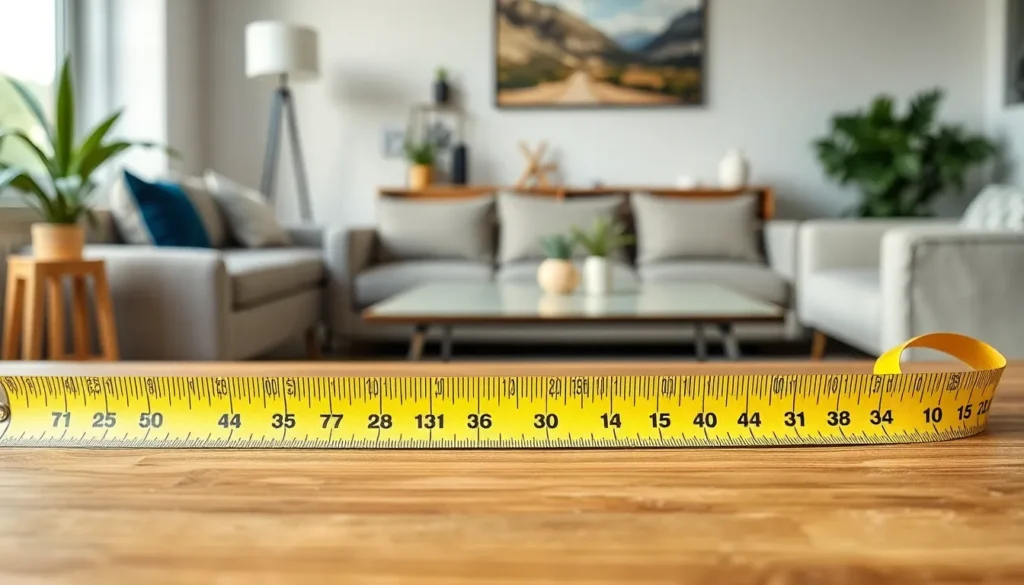When it comes to measuring things, centimeters and inches can feel like they’re speaking different languages. One’s all about precision while the other loves to keep it casual. So why does this matter? Well, whether you’re trying to fit a new couch in your living room or figuring out if those shoes will actually fit, understanding how to convert from centimeters to inches is key.
Table of Contents
ToggleUnderstanding Measurement Units
Measurements play a crucial role in everyday life. Centimeters are often used in precise applications like scientific measurements and technical specifications. Conversely, inches are more common in informal contexts, such as home design or clothing sizes.
Converting centimeters to inches requires knowing the exact conversion factor. One inch equals 2.54 centimeters. Therefore, to convert centimeters to inches, divide the number of centimeters by 2.54.
Examples illustrate this connection. If something measures 10 centimeters, the equivalent in inches is approximately 3.94 inches (10 ÷ 2.54). Having this knowledge simplifies tasks like choosing the right furniture or selecting the appropriate shoe size.
Understanding these units also assists in global communication. Some countries use the metric system exclusively, while others may rely on the imperial system. Being familiar with both centimeters and inches fosters clearer dialogue when discussing measurements.
Applications of both units appear in various fields. Architects may use inches for building plans, while scientists lean on centimeters for accuracy. Recognizing when to apply each measurement enhances clarity and precision.
Knowledge of measurement units, including the conversion between centimeters and inches, is essential for numerous practical situations. Clear comprehension ensures effective communication and precision in everyday tasks.
Importance of Conversion from Cm to Inches

Conversion from centimeters to inches plays a vital role in various contexts, ensuring accuracy in measurements. Many professionals and individuals regularly encounter situations requiring conversions to adapt to different measurement systems.
Everyday Applications
Fitting furniture in homes often demands precise measurements. Understanding how to convert cm to inches allows people to choose the right sizes for their spaces. Additionally, buying clothing or shoes frequently involves knowing the correct sizes in different systems. Parents also benefit when purchasing kids’ clothing from various brands, as size standards vary. Knowledge of this conversion enhances overall shopping efficiency.
Fields Using This Conversion
Numerous fields depend on conversions between centimeters and inches for clarity and precision. Architects frequently use both measurement systems when designing buildings to cater to diverse client preferences. Engineers, too, rely on accurate conversions in construction projects that involve international specifications. Furthermore, health professionals often convert centimeters into inches when assessing patient heights. This knowledge facilitates effective communication across industries and countries, bridging gaps in measurement practices.
Conversion Process
Understanding the conversion from centimeters to inches is essential for accuracy in various applications. This process involves straightforward calculations and available tools.
Using Formulas
To convert centimeters to inches, a specific formula applies. The calculation involves dividing the number of centimeters by 2.54. For example, if a piece measures 10 centimeters, the conversion to inches becomes 10 ÷ 2.54, which equals approximately 3.94 inches. This straightforward formula allows quick conversions for everyday measurements. Consistent practice of this formula enhances familiarity with conversions, benefiting those involved in fields where precise dimensions matter.
Utilizing Conversion Tools
Many online conversion tools assist with transforming centimeters into inches effectively. These tools require users to enter the centimeter value and instantly provide the equivalent in inches. Websites and mobile apps simplify this process, offering additional features like unit comparisons. For instance, one popular conversion tool offers a clear interface for quick calculations. Many professionals find these tools invaluable, especially when working on projects needing multiple conversions. Users save time and reduce errors with these resources, ensuring accurate results in various contexts.
Common Mistakes to Avoid
Avoid neglecting the conversion formula. Many individuals forget that 1 inch equals 2.54 centimeters. Consistent application of this knowledge ensures accurate conversions.
Ignoring decimals presents another common mistake. Some people round numbers too early during the calculation, leading to significant inaccuracies. Maintaining precision throughout the process helps achieve reliable results.
Using incorrect tools can complicate measurements. Relying solely on online converters may lead to errors, especially if input values aren’t checked against reliable sources. Cross-referencing these results with manual calculations provides additional assurance.
Neglecting unit labels also leads to confusion. It’s essential to clearly indicate whether measurements are in centimeters or inches to avoid misunderstandings. Labeling ensures clarity in communications, particularly in professional settings.
Overlooking context can create issues as well. Measurement requirements often differ in fields like engineering and home design. Understanding the specific uses for centimeters or inches enhances accuracy in various applications.
Failing to double-check results is easy but critical. Mistakes during conversion can occur at any stage, and reviewing calculations minimizes errors. Taking a moment to verify details fosters greater confidence in the final measurements.
Relying solely on memory can be misleading. Conversion rates should be readily accessible, preventing mistakes when working on projects. Keeping reference materials handy supports accurate and swift conversions throughout tasks.
Practical Examples
Understanding conversions can simplify tasks. For instance, converting 30 centimeters to inches requires a simple calculation. Divide 30 by 2.54, resulting in approximately 11.81 inches.
Measuring furniture presents another scenario. A couch that measures 200 centimeters translates to about 78.74 inches. This conversion proves helpful when fitting a space precisely.
In the clothing industry, shoe sizes often require these conversions. A shoe size of 25 centimeters equals roughly 9.84 inches. Accurate conversions assist shoppers in finding the right fit across different brands.
Healthcare professionals often use centimeter-inch conversions as well. For example, a patient’s height listed as 180 centimeters is about 70.87 inches. This measurement becomes crucial for determining appropriate medical equipment sizes.
Additionally, graphical design and architecture heavily rely on these conversions. An architectural drawing that specifies dimensions in centimeters can be difficult to understand without conversions. An element measuring 150 centimeters translates to approximately 59.06 inches.
Online tools can further aid in achieving accurate conversions. Several websites provide instant conversions, where users input centimeters for immediate inch results. However, double-checking these results ensures precision, especially in critical applications.
Mistakes can arise during conversions. Ignoring decimal points might lead to significant errors. Keeping a calculator handy or using reliable online tools minimizes the chance of inaccuracies. Properly labeling units and cross-referencing results also enhances clarity in communication.
Understanding the conversion from centimeters to inches is essential for accurate measurements in various aspects of daily life. Whether it’s fitting furniture or selecting clothing sizes knowing how to convert these units ensures that individuals make informed decisions.
With the straightforward calculation of dividing centimeters by 2.54 users can easily navigate between the two measurement systems. Embracing online tools and calculators further streamlines this process while maintaining precision.
By being mindful of common pitfalls and double-checking results individuals can avoid inaccuracies. This knowledge not only enhances personal projects but also fosters effective communication across multiple industries.

